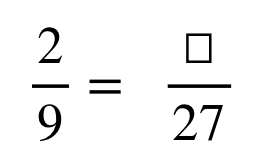Topic Content:
- How To Find Equivalent Fractions
To find an equivalent fraction with a larger numerator and denominator, simply multiply both the numerator and the denominator of the given fraction by the same number.
For example:
\( \frac {2}{3} = \frac {2}{3}\: \times \: \frac {3}{3}= \frac {6}{9} \)That is, \( \frac {2}{3}\)is equivalent to \( \frac {6}{9}\)
Worked Example 7.2.1:
Convert \(\frac{2}{9}\) into an equivalent fraction with the denominator 27.
Solution

Divide the second denominator by the first denominator to obtain the multiplier.
You are viewing an excerpt of this Topic. Subscribe Now to get Full Access to ALL this Subject's Topics and Quizzes for this Term!
Click on the button "Subscribe Now" below for Full Access!
Subscribe Now
Note: If you have Already Subscribed and you are seeing this message, it means you are logged out. Please Log In using the Login Button Below to Carry on Studying!



Responses